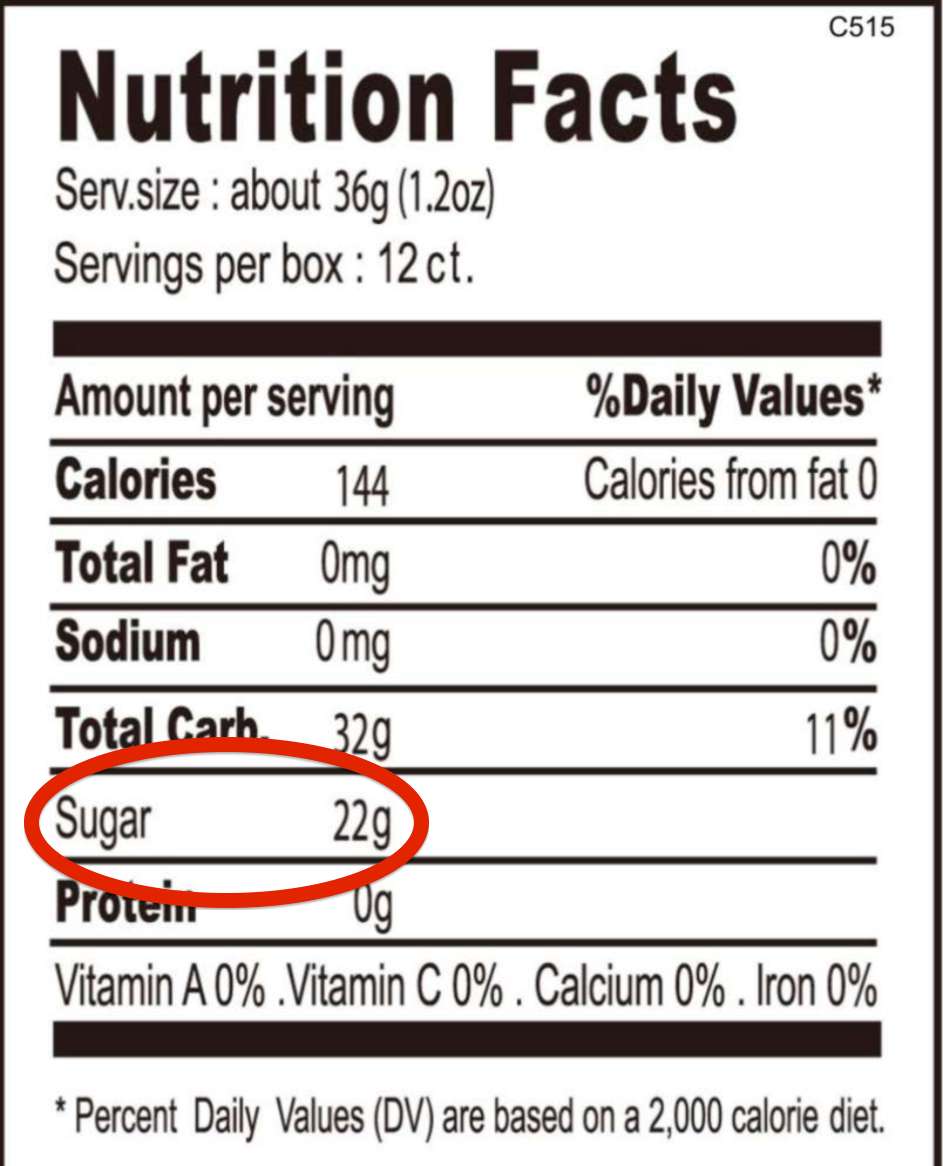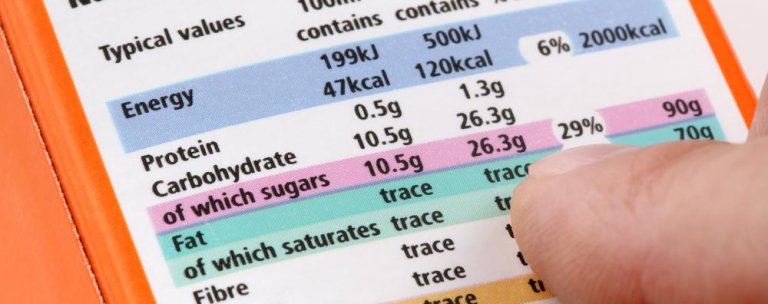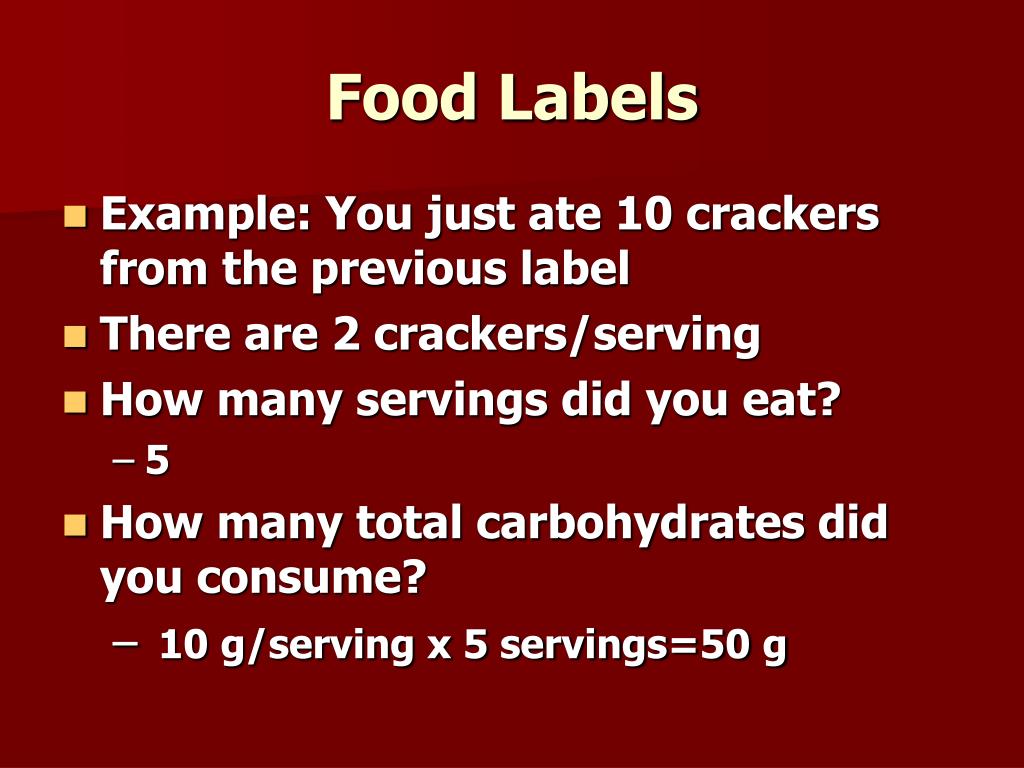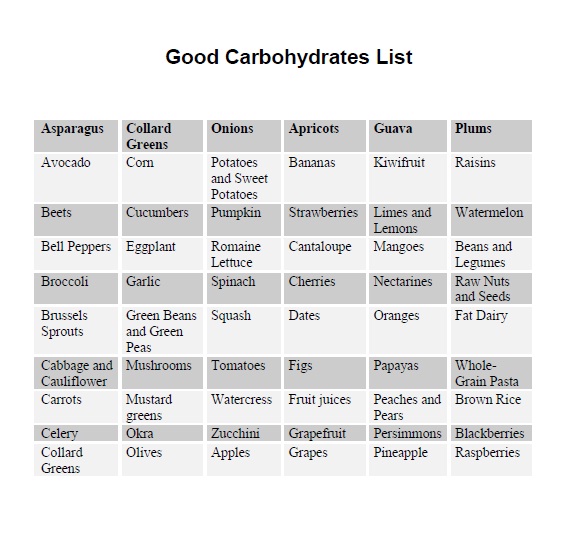43 how to read food labels carbohydrates
How to Read Food Labels | Your Low Carb Hub The below label shows there are 4.3g of carbs in a 15ml serving size which is equivalent to one tablespoon. 3.4g of this is sugar. There is 22.7g of sugar in 100ml, that's 5.6 teaspoons of sugar. The World Health Organisation (WHO) recommends no more than 5-10 teaspoons of added sugar in an entire day. Be aware of hidden sugars. How to Use the Nutrition Facts Label — Diet Doctor 3. Calculate net carbs per serving. Third, check the grams of dietary fiber per serving (circled in green, above). Subtract the fiber (green) from the total carbohydrates (blue) to get the net carbs. This chocolate has 9 grams of net carbs per serving (14g carbs - 5g fiber = 9g net carbs).
How to Read Food Labels & Count Carbs | Allulose Carbohydrates can come from sugars, starches and fiber. Sugars can occur naturally in food (such as fructose in fruit) or can come from added sugar such as table sugar (sucrose). Read the Ingredients List Foods and beverages with more than one ingredient must list them here, in descending order by weight.

How to read food labels carbohydrates
This Is How to Read a Nutrition Facts Label on the Keto Diet 1 gram of carbohydrate = 4 calories (4 units of energy) 1 gram of fat = 9 calories (9 units of energy) You don't have to memorize these values, but simply keep in mind that calories are the sum total energy of the protein, carbs, and fats found in food, and they strongly influence whether you lose, maintain, or gain weight. Low Carb Guide to Understanding Nutrition Labels - Virta Health Sugar should be zero as often as possible (1-2g at most). Fiber is a carb and should be included in your total for the day (initially 30g or less). Again, pay attention to the serving size. Something might be low in carbs, but if you eat 3 or 4 servings, you can easily go over your daily limit. 7. Food Groups for Carbohydrates, Proteins, Fats, Vitamins 02/04/2020 · According to the National Center for Health Research (NCHR), the USDA recently replaced the food pyramid that was introduced years ago. Instead of the pyramid shape — which the NCHR says was criticized for confusing consumers — the new "ChooseMyPlate" recommendation contains five food groups of unequal sections, which include a hearty mix of …
How to read food labels carbohydrates. How to Read Nutrition Labels: Fat Content, Carbs & What To ... - HighKey The Nutrition Facts label lists three requirements for carbohydrates: Total Carbohydrates, Dietary Fiber, and Total Sugars. This section of the label is where you'll see if a product has any added sugar (a low-carb and general dietary no-no!) as well if the product uses Sugar Alcohols to add sweetness. How to Read Food Labels Without Being Tricked - Healthline Still, processed foods that are labeled low-carb are usually still processed junk foods, similar to processed low-fat foods. Made with whole grains. The product may contain very little whole ... How to Read the New Food Label The percent daily value (%DV) can be used as a quick guide to the food label. Try the 5/20 rule when reading a label. Think about 5% or less as low for any nutrient and 20% or more is high for any nutrient. The %DV is a great way to compare food products if the serving size is the same. Fiber is the nutrient on the label that you want to aim ... Food energy - Wikipedia Many governments require food manufacturers to label the energy content of their products, to help consumers control their energy intake. To facilitate evaluation by consumers, food energy values (and other nutritional properties) in package labels or tables are often quoted for convenient amounts of the food, rather than per gram or kilogram; such as in "calories per serving" or "kcal per 100 ...
Reading Food Labels for Carbohydrates - dummies To find the amount of carbohydrates in your foods, follow these steps: Look for the line that reads "Total Carbohydrate" on the label. The value on this line will tell you how many grams of carbohydrates are in one serving of the food. Check the number of servings per container to see if your package has one or more servings. Food labels - NHS Nutrition labels are often displayed as a panel or grid on the back or side of packaging. This type of label includes information on energy (kJ/kcal), fat, saturates (saturated fat), carbohydrate, sugars, protein and salt. It may also provide additional information on certain nutrients, such as fibre. Food Labels: Carbohydrates | Home & Garden Information Center The Daily Value (DV) for total carbohydrate is 300 grams (g) or 100% DV, based on a 2,000-calorie diet. This number combines several types of carbohydrates: dietary fiber, sugars and complex carbohydrates. Listed below total carbohydrate on the food label are the values for dietary fiber and sugars. Food Labels | Nutrition.gov Food and Drug Administration (FDA) regulates the safety of food for humans and animals, including foods produced from genetically engineered (GE) plants, sometimes referred to as "genetically modified organisms" (GMOs). Find out more about the safety of GE plants, and how they are regulated here.
How To Read Food and Beverage Labels | National Institute on ... Feb 24, 2022 · Sometimes, food and beverage packaging includes terms that may try to convince the consumer the food is healthy. To help avoid confusion, the FDA sets specific rules for what food manufacturers can call “light,” “low,” “reduced,” “free,” and other terms. This type of labeling may have little to do with how nutritious the food is. Carb vs. Sugar: How to Understand Nutrition Labels - The LOOP Blog Understanding Nutrition Labels. Carbohydrates are actually comprised of three nutrients: carbohydrates, fiber, and sugar. You may, and will see, foods that are very low in "sugar" but high in carbohydrate. Example 1. Let's look at a popular unflavored old fashioned oats label. Here we see that the total sugar is 1 gram. Looks great right? How To Read Nutrition Labels (Infographic) | Crunch Fitness Saturated Fat. Carbohydrate. Sugars. Sodium. Any labels present on the packaging that make a claim like 'good source of fibre' must substantiate this claim in the nutrition panel. These nutritional values are displayed most commonly in two ways - 'serving size' and 'quantity per 100g'. How to Read a Food Label to Make Sure It's Keto in 3 Easy Steps Subtract Dietary Fiber and Sugar Alcohols (if any) from the Total Carbohydrate. *Total Carbohydrate minus Dietary Fiber, minus Sugar Alcohol (if any) = Net Carbs Total Carbohydrate ( 4 grams) - Dietary Fiber ( 1 gram) = 3 gram s Net Carbs The Total Carbs for ⅔ cup of this packaged cauliflower is 4 grams, and the Net Carb is 3 grams. Why the 2 camps
How to Read a Food Label | Atkins Here's what you should be aware of on a nutrition label: Serving size (if you have more than one serving, be sure to add in the carbs) Total carbohydrates expressed in grams Amount of dietary fiber expressed in grams (subtract from total number of carbs to get the net carb count) Sugars expressed in grams
Learning To Read Labels :: Diabetes Education Online On a nutrition food label, subtract the fiber from the total carbohydrate amount. When you read food labels, the grams of sugar are already included in the total carbohydrate amount, so you do not need to count this sugar amount separately. The grams of sugar listed include both natural sugars, from fruit or milk, and added sugars.
How To Read Nutrition Labels (Like a Pro) - Ditch The Carbs Firstly you need to understand the difference between total and net carbs. TOTAL CARBS = sugars + starches +fibre NET CARBS = total carbs - fibre Carbohydrates will be on the nutrition label are often broken down into carbohydrates, sugars, starch, and fiber. However, each brand may display its nutritional contents differently.
How to read food labels | healthdirect Sugar: Sugar is a type of carbohydrate. It is better to choose healthier carbohydrates and to limit foods that are high in added sugars. Fibre: High fibre foods such as wholegrain bread and cereals improve digestion and help you to feel full. Sodium: This tells you how much salt the product contains. Eating too much salt is linked to high blood pressure and can lead to heart disease, …
PDF Read the Food Label for Carbohydrates - National Institutes of Health Read the Food Label for Carbohydrates Food labels help you choose foods that are lower in calories and in carbohydrates and sweeteners. Here is a food label for a 12-ounce regular soda. The label provides lots of useful information. 1. Serving Size and Number of Servings The serving size is 12 ounces. There's 1 serving in this container. 2.
Food Labels | CDC - Centers for Disease Control and Prevention Check the Serving size first. All the numbers on this label are for a 2/3-cup serving. This package has 8 servings. If you eat the whole thing, you are eating 8 times the amount of calories, carbs, fat, etc., shown on the label. Total Carbohydrate shows you types of carbs in the food, including sugar and fiber.
Understanding Ingredients on Food Labels | American Heart ... Mar 06, 2017 · There are many terms used for sugar on food labels. You might see sugar listed as the fourth ingredient in a product and think it’s not so bad. But sugar can also be listed as high-fructose corn syrup or corn syrup, agave nectar, barley malt syrup or dehydrated cane juice, to name just a few. Read more about sugar and sweeteners.
How To Calculate Net Carbs On Labels? - Cooking Tom Net carbs are the amount of carbohydrates remaining in a food, including the carbohydrates that have been removed from the food during the preparation process. Net carbs are expressed in milligrams (mg) per gram (g) of the food. For example, a serving of pasta has a net carbohydrate content of 12.5 grams of carbohydrate per serving.
Fats, sugar, carbs: How to read a food label (and seven ... - Good Food The "total carbohydrate content" of the food will actually include the sugars within this number and give you an idea of the amount of fuel a food contains. For example, if you consider that a slice of bread or a piece of fruit contains 15-20 grams of carbs per serve, then a food that contains 60-80 grams of carbs per serve is an energy-dense ...
Understanding food labels | Diabetes UK Labels on the front don’t include the amount of carbs, so check the label on the pack for the total carbohydrate, which includes carbohydrates from starchy food as well as sugars. The figures for sugars on traffic lights are for total sugars, which doesn’t tell you how much of the sugar comes from natural sources, such as fructose and how ...
Reading Food Labels | ADA - American Diabetes Association The Nutrition Facts labels on foods are really the key to making the best choices. We'll cover the basics so that these labels make shopping easier for you. Get started Understanding Carbs You've heard it all. From carb-free to low-carb, to whole and empty carbs, it's hard to know what it all means. Learn more Food & Blood Sugar
How to read food labels: MedlinePlus Medical Encyclopedia This number helps determine how foods affect your weight. The total carbs (carbohydrates) are listed in bold letters to stand out and are measured in grams (g). Sugar, starch, and dietary fiber make up the total carbs on the label. Sugar is listed separately. All of these carbs except fiber can raise your blood sugar.
How to Understand and Use the Nutrition Facts Label | FDA - U.S. Food … For certain products that are larger than a single serving but that could be consumed in one sitting or multiple sittings, manufacturers will have to provide "dual column" labels to indicate the...
Food Labels (for Teens) - Nemours KidsHealth Food labels provide more than just nutrition facts. They also tell you what's in a packaged food (i.e., the ingredients). People with food allergies need to check ingredient lists to avoid foods that can cause an allergic reaction. Some food labels also state which country the food came from, whether the food is organic, and certain health claims.
Reading food labels: Tips if you have diabetes - Mayo Clinic Look for foods with 3 or more grams of fiber. Put sugar-free products in their place Sugar-free doesn't mean carbohydrate-free. Sugar-free foods may play a role in your diabetes diet, but remember that it's equally important to consider carbohydrates as well. A sugar-free label means that one serving has less than 0.5 grams of sugar.
Reading Food Labels When You Have Diabetes - WebMD At least 25% less cholesterol and 2 g or less of saturated fat. Calorie free. Less than 5 calories. Low calorie. 40 calories or less. Light or lite. 1/3 fewer calories or 50% less fat. Other ...
Food Groups for Carbohydrates, Proteins, Fats, Vitamins 02/04/2020 · According to the National Center for Health Research (NCHR), the USDA recently replaced the food pyramid that was introduced years ago. Instead of the pyramid shape — which the NCHR says was criticized for confusing consumers — the new "ChooseMyPlate" recommendation contains five food groups of unequal sections, which include a hearty mix of …









:max_bytes(150000):strip_icc()/LabelA2-56a5c0f65f9b58b7d0de5351.jpg)

Post a Comment for "43 how to read food labels carbohydrates"